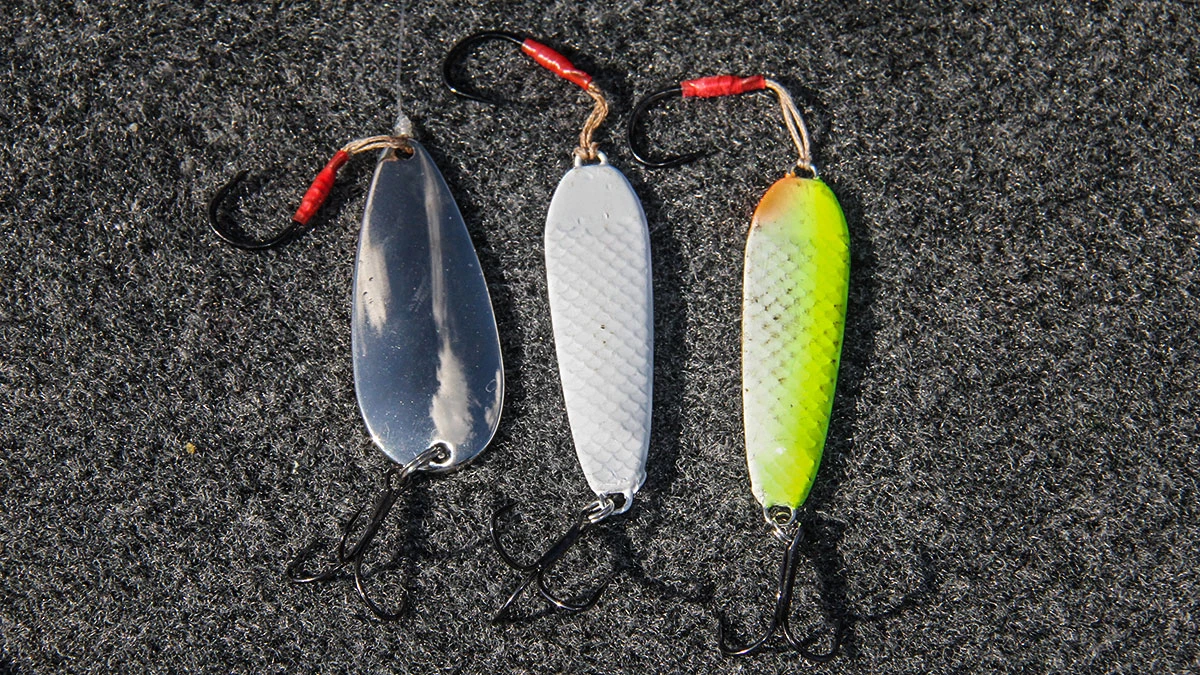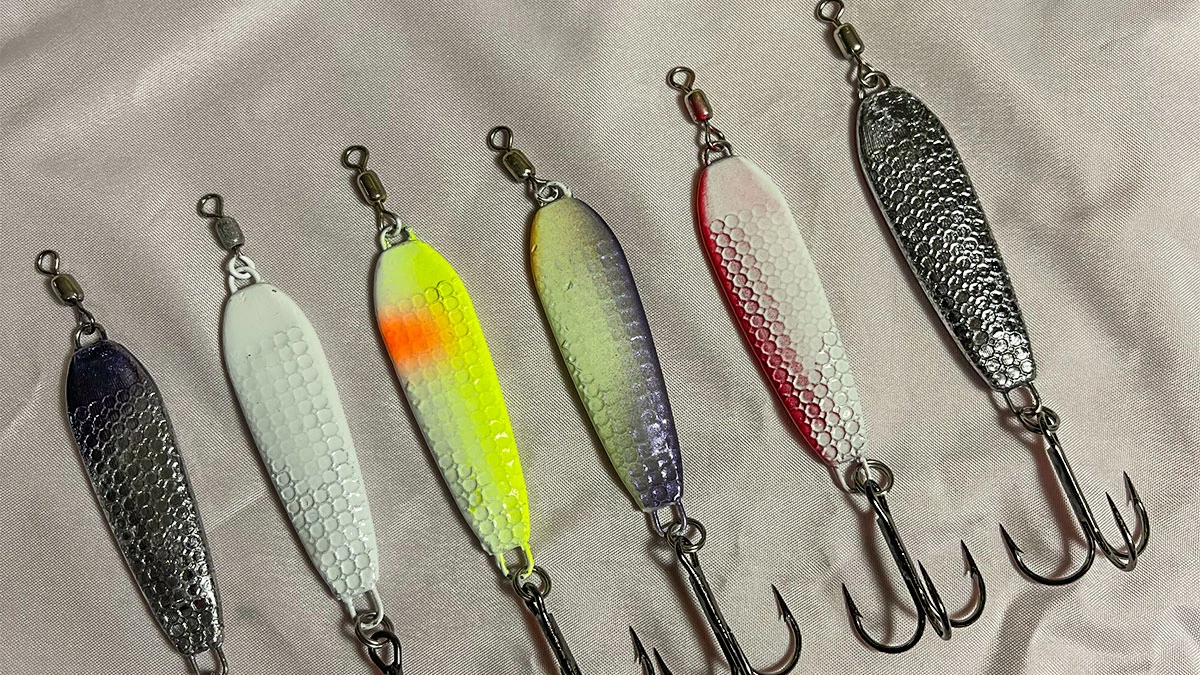Ask Tom Murphy about his favorite early winter bass fishing tactic and he’ll happily spoon feed you the details. Fact is, the Missouri pro is confident that his best shot at early winter fireworks will come by way of a jigging spoon.
“I’ve won big bass many times in the early winter and it’s either been a spinnerbait in muddy water or my slab spoon around docks,” Murphy said.
A longtime fan of the slab spoon technique, Murphy has been building his own Dixie Jet spoons for about 20 years. For targeting fish under deep reservoir docks, the design is straightforward and efficient, with a bottom-line attraction that’s basic match-the-hatch appeal.
“The shad are transitioning from the deep water of the main lakes to the backs to the creeks and cove arms and they’re stopping on those big, deep docks,” Murphy said. “When you see big schools of shad with bass underneath them, you can drop a slab spoon down there and just start whacking them.
“Those fish will be down 15 to 40 feet and with your forward-facing sonar, you can see the jig go down there and watch the fish react. You start popping it right above their heads and it will stimulate a strike just about every time.”
The premise is simple: A jigging spoon resembles the baitfish profile well enough to fool a bass but the weight and design give it an elusive action that prohibits close inspection.
“If you have fish that are suspended under the dock floats or the seawall or breaker wall, the spoon gives them time to see the bait,” Murphy said. “It stays in their area for a little bit, before it tips and goes straight down.
“When it hits the water, it will dart left, dart right and then it will point toward the bottom and it just falls quickly and they turn and go after it. It’s totally a reaction strike, it’s like something blew by them and they want to go after it and kill it.”
Bait specs
Murphy makes a 1/2- and a 7/8-ounce slab spoon, but unless the bass are playing hard to get, he uses the latter. Crappie tend to intercept the slower-falling 1/2-ounce size and, while that’s not a bad deal if you’re double dipping on a sport-fishing/grocery trip; it does burn a lot of time for those locked on a bass mission.
“You’ll catch a limit of crappie before you catch a limit off bass on the smaller spoon; that’s why I use the 7/8-ounce,” Murphy said. “Those docks are thick with crappie and you have to get those spoons down past the crappie to get to the bass.
“If you want to give that bass more time to see the bait, you might go with the 1/2-ounce size. If they’ve gotten fussy or if they’re wanting to eat a smaller bait, that size might produce.”
(Sidenote: While he’s mostly jigging in open water, Murphy points out that the lighter slab spoon navigates brush better.)
Murphy favors a white slab spoon, but he’ll also throw coleslaw color, blood line (white with a red streak) and, occasionally, Table Rock shad. With each one, he complements his spoon’s wide gap treble by attaching a stinger hook to the top end. When the bite’s on, double headers are common — especially with spotted bass.
Presentation
“I’ll flip my bait in there and let it free spool down,” Murphy said. “I know the depth I’m in, so if I’m watching my reel and all of a sudden the line stops and it’s only been a couple of seconds, I know a fish already has it, so I’ll stop it and set the hook.
“Normally, if they’re high in the water column, they’ll get it on the fall. If they’re down deeper, I’ll let it go clear to the bottom and then bring it up with a double-pump cadence.”
These strategies appeal to all three of the common black bass species; however, Murphy tends to find smallmouth closer to the bottom. Spots and largemouth, could vary greatly.
“Some days they’ll be a foot or two below the dock flotation; other days, they’ll be down deeper following the balls of shad,” he said. “They’re just going the length of the dock at whatever depth those shad are at.”
Murphy finds a 6-foot, 6-inch medium- to medium heavy-action baitcaster with a fast-soft tip ideal for what it is typically a close-range game. A Lew’s 7:1 reel provides plenty of speed to quickly maneuver a fish out from the dock where lifts and cables threaten calamity.
The approach
Murphy generally starts in about 20 feet of water and progresses out as deep as he needs to go until he finds what he’s looking for. Working from end to end, he certainly won’t ignore obvious bass, but it’s the buffet line that gets his attention.
“I’m not even looking for bass; I’m just looking for shad and crappie,” Murphy said. “Where they’re at, the bass will be there.
“I also need sunshine to position these fish under docks. When it’s cloudy the fish could be out roaming and they could be in 100 feet of water.”
The same dynamics often find dock stalls packed with crappie. Sometimes, these tasty interlopers form such a meat mass that Murphy has to use strategic presentations.
“I try to avoid the big schools of crappie because they’ll go from 10 feet down to 20 feet and it will be solid, two to three slips full of crappie,” he said. “I try to get to the left or right of that, so I can see the bass that are sitting there waiting for the shad that (the crappie) are killing early winter down through the water column.”
Murphy will start on the dock’s shady side, as bass find their best ambush angles there. Sit in darkness, watch the lighter edge for passing food and eat at your leisure — pretty good game plan.
A 7-pound, 14-ounce bass on Lake of the Ozarks tops Murphy’s personal best, but dock spooners will find plenty of 4- to 5-pounders to keep life interesting. Bolstering the fun, early winter schoolers could pop up at any time.
“White bass in particular, absolutely love that slab spoon,” Murphy said. “You can throw it at suspending fish or schooling fish. Normally, those fish are from the surface to 10 feet down in the water column busting shad.
“That quick little flutter left or right and then the fast fall through those fish, they chase it. They’re hungry and they’re killing baitfish.”















